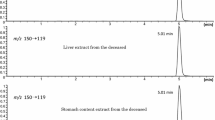Abstract
Medico-legal experts are increasingly enlisted to assess the methamphetamine and amphetamine serum concentrations after a criminal offense. However, since criminal users rarely provide useful information to medico-legal experts regarding the substances abused, when the substance(s) was/were used, dose of ingestion tools are needed to interpret the analytical data, which can be used as objective evidence in such cases. A comparative series of methamphetamine and amphetamine serum concentrations were used to analyze the frequency of concentrations, to determine methamphetamine/amphetamine concentration ratios, and prove them as a tool to distinguish pure methamphetamine from mixed amphetamine/methamphetamine ingestion. Additionally, two cases of survived accidental methamphetamine intoxication, resulting from ingestion smuggling which was longitudinally monitored, and pharmacokinetic parameters were assessed. In a series of 628 samples where the most frequent concentration of methamphetamine exceeded the therapeutic level, there was a strong correlation suggesting pure methamphetamine consumption, when the ratios of methamphetamine/amphetamine concentrations were within the range between 3 and 10. In the two cases of methamphetamine bodypacking, the relevant serum concentrations of methamphetamine and amphetamine, which could be measured up to 9 days after ingestion, indicated a decrease of the methamphetamine/amphetamine ratios in an exponential manner. However, the ratios were not always within the range between 3 and 10. Lastly, the course of the serum concentrations suggested an increase of the apparent elimination half-life of methamphetamine. In terms of the objective evidence required in criminal law, calculating methamphetamine/amphetamine concentration ratio is not a suitable to means to distinguish pure methamphetamine intake and that of mixed amphetamine/methamphetamine abuse in an individual case. Instead, methamphetamine high serum concentrations and the possible increase in apparent elimination half-life suggest that an extended detection period may be used to distinguish between “illicit use” as compared to “therapeutic use” of methamphetamine.



Similar content being viewed by others
References
Courtney KE, Ray LA (2014) Methamphetamine: an update on epidemiology, pharmacology, clinical phenomenology, and treatment literature. Drug Alcohol Depend 143:11–21
Cruickshank CC, Dyer KR (2009) A review of the clinical pharmacology of methamphetamine. Addiction 104(7):1085–1099
Musshoff F, Madea B (2012) Driving under the influence of amphetamine-like drugs. J Forensic Sci 57(2):413–419
Schulz M, Iwersen-Bergmann S, Andresen H, Schmoldt A (2012) Therapeutic and toxic blood concentrations of nearly 1,000 drugs and other xenobiotics. Crit Care 16(4):R136
Jones AW, Holmgren A (2012) Concentration ratios of methamphetamine to amphetamine in blood can help to distinguish use of methamphetamine from various mixtures of the two stimulants. J Anal Toxicol 36(9):634–637
Li RB, Guan DW, Zhu BL, Zhang GH, Zhao R (2009) Death from accidental poisoning of methamphetamine by leaking into alimentary tract in drug traffic: a case report. Leg Med (Tokyo) 11(Suppl 1):S491–S493
Takekawa K, Ohmori T, Kido A, Oya M (2007) Methamphetamine body packer: acute poisoning death due to massive leaking of methamphetamine. J Forensic Sci 52(5):1219–1222
Kumral B, Buyuk Y, Yesiloglu F, Ozkan OL (2014) A fatal case of heroin body packing in Turkey. Forensic Toxicol 32(2):338–339
Heinemann A, Miyaishi S, Iwersen S, Schmoldt A, Püschel K (1998) Body-packing as cause of unexpected sudden death. Forensic Sci Int 92(1):1–10
Cappelletti S, Piacentino D, Sani G, Bottoni E, Fiore PA, Aromatario M, Ciallella C (2016) Systematic review of the toxicological and radiological features of body packing. Int J Legal Med 130(3):693–709
Uekusa K, Hayashida M, Saito N, Mashiko K, Hara K, Waters B, Ohno Y (2013) Methamphetamine and amphetamine concentrations in survivors of body-packer syndrome in Japan. Forensic Sci Int 227(1–3):45–47
Shappell SA, Kearns GL, Valentine JL, Neri DF, DeJohn CA (1996) Chronopharmacokinetics and chronopharmacodynamics of dextromethamphetamine in man. J Clin Pharmacol 36(11):1051–1063
de la Torre R, Farre M, Navarro M, Pacifici R, Zuccaro P, Pichini S (2004) Clinical pharmacokinetics of amfetamine and related substances: monitoring in conventional and non-conventional matrices. Clin Pharmacokinet 43(3):157–185
Carvalho M, Carmo H, Costa VM, Capela JP, Pontes H, Remiao F, Carvalho F, Bastos Mde L (2012) Toxicity of amphetamines: an update. Arch Toxicol 86(8):1167–1231
Cook CE, Jeffcoat AR, Hill JM, Pugh DE, Patetta PK, Sadler BM, White WR, Perez-Reyes M (1993) Pharmacokinetics of methamphetamine self-administered to human subjects by smoking S-(+)-methamphetamine hydrochloride. Drug Metab Dispos 21(4):717–723
Drug and addiction report (2015). The drug commissioner of the federal government, Berlin
Melega WP, Cho AK, Harvey D, Lacan G (2007) Methamphetamine blood concentrations in human abusers: application to pharmacokinetic modeling. Synapse 61(4):216–220
Molina NM, Jejurikar SG (1999) Toxicological findings in a fatal ingestion of methamphetamine. J Anal Toxicol 23(1):67–68
Albertson TE, Derlet RW, Van Hoozen BE (1999) Methamphetamine and the expanding complications of amphetamines. West J Med 170(4):214–219
de Prost N, Megarbane B, Questel F, Bloch V, Bertaux DC, Pourriat JL, Rabbat A (2010) Blood cocaine and metabolite pharmacokinetics after cardiac arrest in a body-packer case. Hum Exp Toxicol 29(1):49–53
Anggard E, Jönsson LE, Hogmark AL, Gunne LM (1973) Amphetamine metabolism in amphetamine psychosis. Clin Pharmacol Ther 14(5):870–880
Acknowledgements
The authors thank Karen Bluemke-Anbau for the helpful discussions, Dagmar Rumpelt and Kerstin Fehse for their excellent technical assistance, and Wolfgang Weissflog as well as Stan Patti for checking the spelling and grammar in this manuscript.
Author information
Authors and Affiliations
Corresponding author
Ethics declarations
Conflict of interest
The authors declare that they have no conflict of interest.
Rights and permissions
About this article
Cite this article
Weber, M., Lessig, R., Richter, C. et al. Medico-legal assessment of methamphetamine and amphetamine serum concentrations—what can we learn from survived intoxications?. Int J Legal Med 131, 1253–1260 (2017). https://doi.org/10.1007/s00414-017-1607-5
Received:
Accepted:
Published:
Issue Date:
DOI: https://doi.org/10.1007/s00414-017-1607-5




